From soot to sun – the long fight against occupational disease
Has the 250 years’ fight against occupational disease come to its end? Today’s risk factors are not soot, radon or asbestos, says the EU work safety agency. The top risk, is in fact ordinary sunlight.
Measures to improve the working environment have had some success. As a result miner’s lung, hearing and vibration damage, or more modern ailments like repetitive strain injury (RSI), no longer count among the most common occupational diseases. Top of that list now is cancer.
52 percent of all deaths related to occupational diseases in the EU are caused by cancer, according to the European Agency for Safety & Health at Work, EU-OSHA, statistics. Coronary heart disease represents 24 percent of the 106,000 annual deaths, while workplace accidents make up only two percent. All other diseases make up 22 percent of deaths.
Skin cancer is the most common of the cancers. The most common cause among workers – by a great margin – is exposure to sunlight during outdoor work.
The high number of sick workers is not, however, a result of what people are being exposed to today, since many types of cancer develop over a long period of time. The greatest impact on the statistics is the type of working environment people had 10 to 30 years ago.
The main cancer-causing factors as listed by the CAREX cancer database for 15 EU countries between 1990 and 1993 are these:
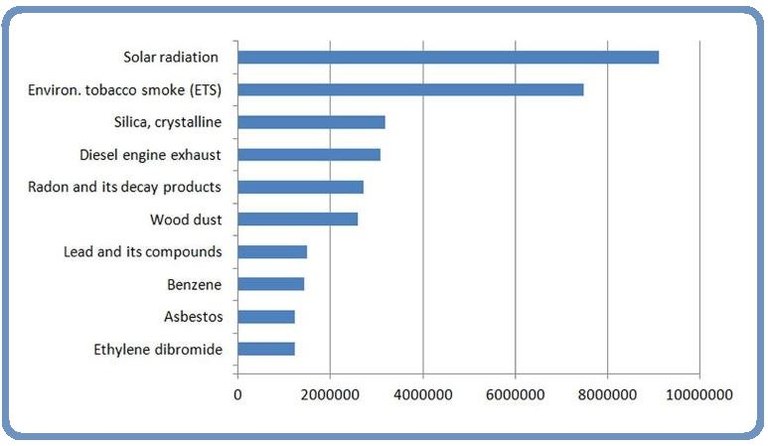
If you include all of the EU 28 the number is even higher. 14.5 million EU workers are exposed to solar radiation during 75 percent or more of their working hours. That is 7.4 percent of all workers.
Between 1990 and 1993, 7.5 million workers were exposed to passive smoking, which was then the second largest risk. Since then, smoking bans in workplaces and restaurants has reduced the number of people exposed to this.
Respirable crystalline silica (very fine dust containing quartz), diesel fumes and wood dust were relatively equal. 2.5 to just over three million workers were exposed to these hazards.
Strong correlation
The International Agency for Research on Cancer IARC, part of the WHO, concluded that there was “sufficient evidence in humans for the carcinogenicity of solar radiation” as early as in 1992.
There are three types of skin cancer:
Malignant melanoma is the most dangerous kind. It develops gradually from skin cells that start to grow uncontrollably. In the last stage, it creates metastasis which spread to other parts of the body.
Squamous cell carcinoma is an external cancer which attacks the most sun-exposed skin. Survival rates are good if treated early.
Basal cell carcinoma is the most common type of skin cancer. It does not spread and treatment is nearly always successful.
Malignant melanoma can also have genetic causes, but researchers say an obvious link between UV exposure from the sun and the risk of developing both squamous cell and basal cell carcinoma has been known at least since 2011.
Summing up the research, the German skin cancer researcher Claas Ulrich and researchers from ten other countries write: “It is unfathomable that many EU member states have yet to translate that knowledge into adequate strategies to prevent the disease.”
The skin cancer rates among fair-skinned people in Europe, Australia and North America have grown by three to eight percent year on year for the past 30 years. These are statistics from Sweden:
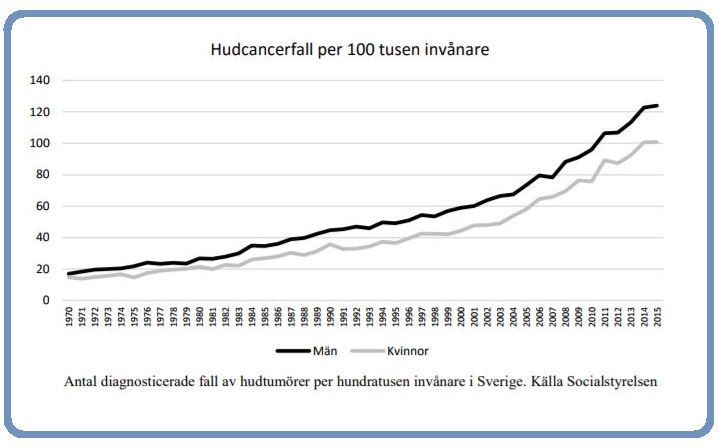
The number of skin cancer cases increases among people with fair skin. The graph shows the number of cases per year and 100 000 inhabitants. Statistics from Sweden
Despite the large number of skin cancer cases, this is not an occupational disease which gets the attention it deserves, according to Swen Malte John, Professor of Dermatology at the German Osnabrück University, and Nikos Manaras, Senior EU Affairs and Media Coordinator at the European Academy of Dermatology and Venereology.
“Affected workers go unnoticed, un(der-)reported, unscreened, uncared for and uncompensated,” they sum up in an opinion piece in Euractive.
The main reason is that the UV radiation people are exposed to at work is no different from what they are exposed to in their spare time. Then there is the added dosage which is self-imposed by those who use tanning salons or who holiday abroad.
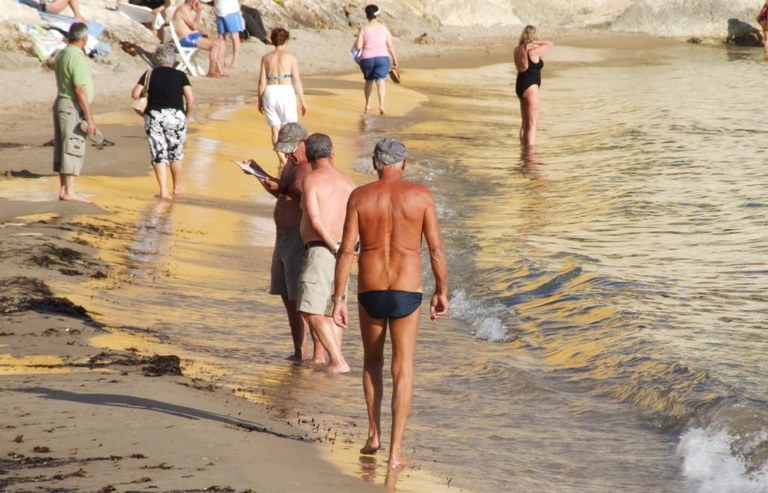
Sun radiation has different effects on different skin types. Researchers divide sensitivity into four groups. On a beach in Spain you can easily spot the differences – and the way different people use more or less protection
Employers can argue that holiday-related sun exposure is the determining factor, but an employee should not be treated differently because he or she has fairer and more sensitive skin than their colleagues.
“People are insured ‘as they come’. This means those with heightened sensitivity can become ill at lower levels of exposure than the average person,” writes Birgitta Meding in a chapter on skin disease as occupational damage, in one of the standard texts about occupational diseases.
Tanning salons increase risk
In 2009, UV radiation from other sources except the sun were also included – to the great disappointment of tanning salons. Studies had shown that sunbeds, where you are exposed to sun radiation three times stronger than the midday sun at the Equator for shorter or longer periods of time, also considerably increase the risk of developing cancer.
The risk was directly linked to how often people had been using a sunbed. Those who had used one 10 times or less were 34 percent more likely to develop malignant melanoma, the deadliest type of skin cancer. Those who tanned themselves 100 times or more saw their risk increase by 272 percent.
Only a few European countries have so far accepted UV radiation from the sun to be a valid reason for receiving compensation for work-related damage. Denmark was one of the first countries to do so in 2005.
Since then, however, only some 50 cases of work-related skin cancer as a result of solar radiation have been reported in Denmark. It is the same in several other countries. But Germany stands out. Within 12 months of work-related squamous cell carcinoma was categorised as an occupational disease on 1 January 2015, 6,000 cases of this type of skin cancer, or preliminary stages of it, were reported.
“The most affected industrial sectors are agriculture and construction with a wide spectrum of other outdoor branches, including public services. The case of Germany undoubtedly gives a first impression of the challenge ahead of us,” writes Claas Ulrich.
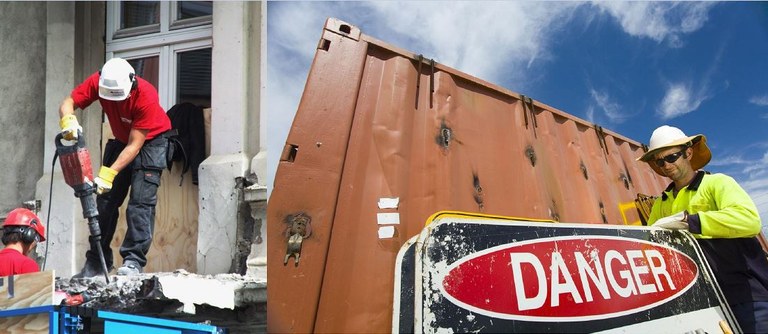
Different attire for outdoor work – workers in Oslo and in Queensland, Australia, where the worker wears long sleeves, sunglasses and a sun hat
When assessing a work-related injury in connection to the possible link between exposure to UV radiation and skin cancer in Sweden, the exposure at work must be greater than exposure during non-working hours.
Germany has taken a different approach, where UV radiation at work must be at least 40 percent of the total dosage. The dosage is calculated in units called SED (standard erythema dose):
The table below shows how many years you need to work outdoors in order to qualify for compensation:
| Age | 50 | 60 | 70 | 80 |
|---|---|---|---|---|
| Lifetime dosage accumulated, (SED) | 6500 | 7800 | 9100 | 10400 |
| Work-related dosage | 2600 | 3100 | 3640 | 4160 |
| Years of compensation-entitled outdoor work | 15 | 18 | 21 | 24 |
The annual non-work-related sun dose in Germany is estimated to be 130 SED annually, 170 SED if outdoor work is included. Source: JDDG
After retirement, the amount of non-work-related sun exposure increases. As a result, in the German system the number of years you need to have been working in order to be entitled to compensation increases.
- Farmers – from low risk to high risk
-
Farmers like Finland Swede Johan Eklund, used to be part of the group of occupations which carried a low risk of occupational disease. But changing sun habits, foreign holidays and tanning salons makes the total exposure so high that measures are needed. Johan Eklund (above) works the fields of Brutuby, Vanda. He lives in Sibbo
- Unbearably long time from diagnosis to treatment
-
 In 1775 the English surgeon Percival Pott wrote a report on several cases of cancer which he had discovered on a London chimney sweep’s testicles. At the time, child chimney sweeps were not uncommon, because they were small and could be lowered into the chimneys. As a result, they spent the years from childhood to old age working in an environment filled with soot, tar and burned coal.
In 1775 the English surgeon Percival Pott wrote a report on several cases of cancer which he had discovered on a London chimney sweep’s testicles. At the time, child chimney sweeps were not uncommon, because they were small and could be lowered into the chimneys. As a result, they spent the years from childhood to old age working in an environment filled with soot, tar and burned coal.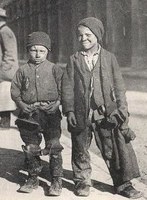
For more than 250 years we have therefore known of the carcinogenic substances present in many working environments. But moving from that knowledge to actually doing something to reduce the risk has often been unbearably long.
As early as in 1870 it was known that many miners in Central Europe were dying from lung cancer. It took 50 years to discover that radioactive dust was the cause. Still,100 years later thousands of American workers continued to work in uranium mines which tripled their risk of developing lung cancer.
At the beginning of the new millennium researchers discovered aromatic amines in colourants used in the textile industry, which led to bladder cancer. In the 1970s, people still worked in industries where they were exposed to substances like benzidine and beta-naphthylamine – in one benzidine factory half of all the employees developed cancer.
50 years ago asbestos was found to not only cause lung diseases, but also lung cancer. But until the mid-1970s, there were dozens of asbestos factories and hundreds of companies using asbestos – in some factories the dust was so thick it stopped light from getting through. 30 to 40 percent of all those who worked with asbestos are thought to have developed lung cancer.
Source: Wikipedia, Cancer and the Worker, red B. Boland and P. Lehman. Painting: Frans Wilhelm Odelmark
 Follow us on Facebook
Follow us on Facebook
